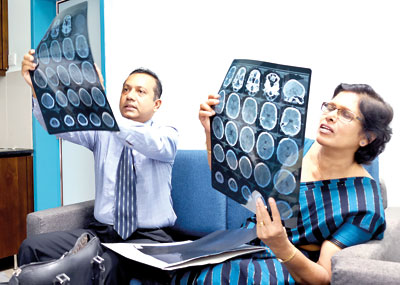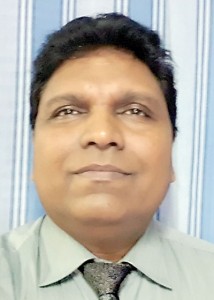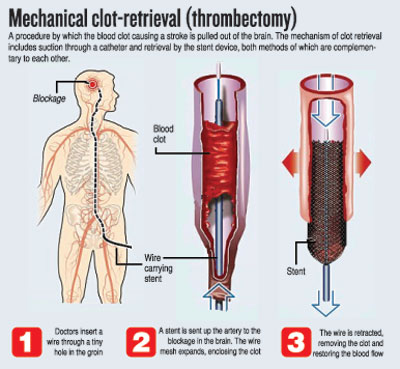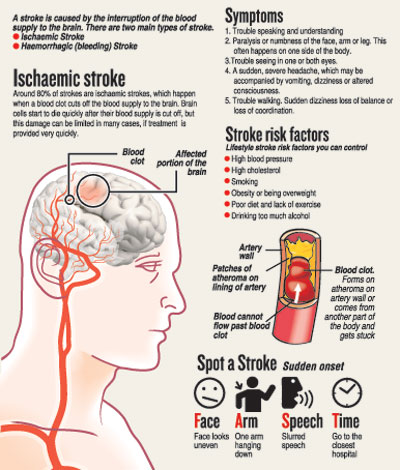News
More hope for stroke victims as NHSL performs first-ever mechanical clot-retrieval procedure
Senior Consultant Neurologist Dr. Padma Gunaratne tells the Sunday Times how stroke-care and treatment work like clockwork at the NHSL
Currently, even in the private sector only one hospital performs this procedure
Stroke treatment has reached its full and world-class potential in the state sector, with the National Hospital of Sri Lanka (NHSL) performing the first-ever mechanical clot-retrieval procedure on Tuesday to ward off the devastating impact of a brain attack.

Dr. Padma Gunaratne and Dr. Prasad De Silva showing the scans
As the fears and tears of a family turned into joy and hope, mother and wife, Piyaseeli Bopitiya, 56, of Kadawatha was sitting up in the Neuro-Intensive Care Unit (NICU) of the NHSL on Thursday, talking to her husband, two days after suffering a massive stroke.
Stressing that the sooner you bring a stroke victim to hospital the better, Senior Consultant Neurologist Dr. Padma Gunaratne who has been an anti-stroke activist for more than two decades, tells the Sunday Times how stroke-care and treatment work like clockwork at the NHSL.
Before dealing with the latest treatment for ischaemic stroke, which is the common type, Dr. Gunaratne explains that systems are strictly in place at the NHSL to give priority to victims of acute stroke at every point.
“Relatives must rush stroke-victims to the Outpatients Department (OPD) of the NHSL, from where they would be quickly prioritized as an emergency and sent through to the Emergency Treatment Unit (ETU). As they are wheeled in, ETU doctors will promptly inform the CT (Computed Tomography) scanning staff as well as the neurology staff and the interventional radiology staff that a victim is on the way,” she says.
Those who worked in tandem on Tuesday to give Piyaseeli the best fighting chance to overcome the stroke are Dr. Gunaratne and Consultant Neurologist Dr. Gamini Pathirana and Senior Registrars in Neurology Dr. Shanika Nandasiri and Dr. Saamir Mohideen. The Interventional Radiology Team included Consultant Interventional Radiologist and Head of Department, Dr. Prasad De Silva; Consultant Interventional Radiologist Dr. Padmasiri Bandaranayake; Consultant Neuro-Radiologist Dr. Chandrasiri Lokubalasuriya; Coordinator Dr. Sampath Athukorala; Anaesthetists Dr. Shiromi Karunarathne and Dr. Ashoka David; Nurse-in-Charge K.P. Sujeewani Priyanthi; Nursing Officers Charith Edirisinghe and Prasad Jayawardane; and Radiological Technologist Suresh Dissanayake.
The protocols are up on the walls of the OPD as well as the ETU, the Sunday Times learns, and before a stroke victim is taken to the neurology ward, an urgent CT scan is performed to determine what type of stroke it is.

Dr. Gamini Pathirana
Eighty percent of strokes or the most common strokes are caused by an occlusion of a blood vessel (blockage or closure of a blood vessel) in the brain called an ischaemic stroke, while 20% are due to a haemorrhagic stroke (when a blood vessel ruptures in the brain). Whether the stroke is ischaemic or haemorrhagic, is identified through a CT scan.
In Sri Lanka, 1% has had a stroke and 1,200 or more stroke patients seek treatment at the NHSL every year, says Dr. Gunaratne.
There are three ways in which a person can suffer an ischaemic stroke:
- A clot (thrombus) can block a small blood vessel in the brain
- A clot can block a large vessel in the brain
- The heart may shoot out clots which can block a large vessel in the brain.
“The worst clinical features, a very poor prognosis and the worst outcome arise when a clot blocks a large vessel,” says Dr. Gunaratne, underscoring the gravity of the situation when large blood vessels supplying the brain get affected. If the left side of the brain is hit by a stroke, it is more disastrous because the stroke-victim’s speech gets affected. This has a major impact on recovery as therapists find it difficult to communicate with the patient.
While strongly advocating the prevention of strokes through a healthy diet and regular exercise, she says that, if however, a person suffers an ischaemic stroke, the immediate measure that needs to be carried out as quickly as possible is “opening” up the blocked vessel to allow the blood to flow through. This needs to be done fast.
Otherwise, the brain cells (penumbra) which are around the cells which have been directly affected, which are dysfunctional but viable, will also die in a few hours.
There are two ways to deal with clots and open up blood vessels – infusing clot-busting medication, which was begun at the NHSL way back in 2008 under the guidance of Dr. Gunaratne and performing mechanical clot-retrieval which was performed on Tuesday for the first time in the state sector, the Sunday Times learns.
Currently, even in the private sector only one hospital performs this procedure.
Clot-busting medication is very viable for blocked small vessels but the answer for large vessels is mechanical clot-retrieval and that is the treatment that was administered to Piyaseeli on Tuesday.
“Research carried out in 2015 confirms that when a big vessel is blocked the removal of the clot gives the best outcome,” says Dr. Gunaratne, adding that the earlier — within six hours of being hit by a stroke — the procedure is performed the better and the outcome is three times more than not removing the clot.
There is a 40% benefit to the stroke victim, which is a massive improvement as her/his speech can be saved and rehabilitation begun immediately.
Showering praise not only on her Neurology Team but also on the Interventional Radiology Team and NHSL Director Dr. Kumara Wickramasinghe who made it possible with his support, Dr. Gunaratne details how they put everything into place last December……..and so Piyaseeli became the flag-bearer of the mechanical clot-retrieval treatment at the NHSL.
| Time is of the essence,stresses Dr. Gunaratne | |
| The NHSL is “ready” to provide optimum treatment for stroke victims, reiterates Dr. Padma Gunaratne, pointing out that all systems are set including the ETU, the Neurology Team and the Interventional Radiology Team.“Don’t delay. Bring any person who shows signs of a stroke immediately to the NHSL OPD, as time is of the essence,” is her plea. |

| Flagbearer of the procedure Piyaseeli on the road to recovery | |
The mother of two grown up daughters, Piyaseeli Bopitiya, woke up early on Tuesday morning as usual to prepare her husband’s breakfast and lunch. By 5.20 a.m. when husband K.K. Bopitiya left for work, she had packed both his breakfast and lunch.  Piyaseeli talking to her husband, K.K. Bopitiya in the NICU. Pix by Amila Gamage Usually, she would walk him to the gate, but that day she didn’t do so and he was surprised so he said bye about twice before he left. It was around 5.50 a.m. that he got a frantic call from his daughter that “Ammi bathroom eke wetila”. (Ammi has fallen in the bathroom.) Mr. Bopitiya says that his wife had no major illnesses but had undergone two surgeries on the mitral valve of the heart some time ago. She was attending the Cardiology Clinic in Kandy because that was their hometown though they lived in Eldeniya, Kadawatha. It is son-in-law Sarath Kumara who recalls those tense moments on Tuesday morning. While there was pirith on the radio, his wife had heard her mother groaning and moaning in the bathroom. Fortunately, the door was not locked and his wife found her tilted onto the right side. “She seemed lifeless and was foaming at the mouth,” says Sarath. They quickly put her into a car and rushed her to the NHSL. Piyaseeli was growing cold, her mouth was going to a side and she was not talking. When they arrived at the Accident Service at 7.15 a.m. they were told that as she was not injured, she should be taken to the OPD. At the OPD, when the doctors saw the “weakness” that was assailing Piyaseeli, things happened quickly and she was rushed to the ETU and then onto the CT scanning room. With Consultant Neuro-Radiologist Dr. Chandrasiri Lokubalasuriya checking out the scan, it was clear that Piyaseeli had suffered a large-vessel block in an ischaemic stroke, with the clot most probably being shot to the brain by the heart. On the urgent request of Consultant Neurologist Dr. Gamini Pathirana, the Interventional Radiology Team stepped in. Piyaseeli was taken to the state-of-the-art Angiogram Suite where the mechanical clot-retrieval procedure was performed under local anaesthesia. “The clot was blocking the origin of the middle cerebral artery, the largest branch of the internal carotid artery,” says Consultant Interventional Radiologist Dr. Prasad De Silva, explaining how they inserted the catheter through a puncture of the femoral artery in the region of the groin, going up through the aorta to the left common carotid, onto the internal carotid artery and then the blocked middle cerebral artery. They then “engaged” the clot and sucked it out in the first try itself. “She was brought in at around 9.35 a.m. and it took about 10 minutes for the preparation and puncture of the femoral artery and by 9.50 a.m. we were at the site of the clot. The blood circulation in the blocked artery was restored by 10.20 a.m. When we started the procedure she was confused but soon after, began responding to our instructions,” says Dr. De Silva, adding that it was “rewarding” to see the improvement in the patient’s condition. The proof of the success of the procedure is evident – Piyaseeli is talking and she can understand what is being said to her. There is mild weakness of her right limbs which can be addressed through rehabilitation, say the doctors. |

